Digestive System - PowerPoint PPT Presentation
1 / 42
Title: Digestive System
1
Digestive System
- Chapter 14
2
In your groupsyou will come up with a definition
(using YOUR WORDS) and a colored picture of it
happening in the body. You will be presenting
this to the class. YOU MAY NOT USE BOOKS!!!!
- Ingestion
- Physical Digestion
- Mechanical Digestion
- Propulsion
- Chemical Digestion
- Absorption
3
Digestion (at organ and system level)
Ingestion take in food
Physical digestion food breakdown
Mechanical food breakdown segmentation
Propulsion movement of food peristalsis and
swallowing
Chemical digestion breakdown of food molec. by
enzymes
Absorption transport of food from GI tract to
blood or lymph
Defecation elimination of indigestible
substances feces
4
Chemical Digestion vs metabolism
Chemical digestion occurs in system, then cells
use nutrients for metabolism
Anabolism- building up of molecules
Catabolism- breaking down of molecules hydrolysis
5
Digestive System
Accessory Organs
GI Tract (Alimentary Canal)
Teeth Tongue Salivary Glands Liver Gall
Bladder Pancreas
Mouth Pharynx Esophagus Stomach Sm Intestine Lg
Intestine Anus
6
Histology of GI tract wall
Layers Mucosa, submucosa, muscularis, serosa
Lumen opening/hollow center Membrane
peritoneum (visceral parietal)
7
Peritoneum- Membrane
Visceral peritoneum
Peritoneal cavity
Parietal peritoneum
8
Nutrition, Chemical Digestion and Metabolism
- Nutritional polymers broken down into monomers
(or building blocks) during digestion then
metabolized
9
Nucleic acids
proteins
carbohydrates
lipids
10
Carbohydrates
disaccharide
monosaccharide
Monosaccharide - glucose, fructose, galactose
Disaccharides- lactose, maltose, sucrose
polysaccharides
Polysaccharides- starches, cellulose, fiber,
glycogen
Energy source pasta, bread, cellulose, sugar
11
Lipids
Fats, Oils, Waxes, Cholesterol
Insulation, membranes, energy
diglyceride
Fatty acids
12
Lipids
BAD FOR YOU (builds up in arteries leads to
heart disease)
- Saturated Fats increase LDL (butter)
- Unsaturated Fats decrease LDL (vegetable oils)
- Polyunsaturated Fats Omega-3 ( nuts, fish oil,
leafy greens)
13
Proteins
Tissue Maintenance and Growth, enzymes
Amino acids (building blocks)
dipeptide
polypeptide
14
Nucleic acids
RNA
DNA
nucleotide
sugar
15
Digestive organ anatomyand physiology
Oral Cavity Anatomy
Teeth Tongue Cheeks Lips Hard and Soft
Palates Tonsils Uvula Salivary glands- saliva
16
Salivary Gland Secretion
SALIVA
- Contains enzyme called
- salivary amylase
- (starch breakdown)
- chemically digests
- polysaccharide starches
- into disaccharides
- Mumps (disorder) swelling, pain of salivary
glands
17
Oral cavity physiology
1. Ingestion
- 2. 3. Physical digestion
- Mechanical- mastication by teeth, mashing
by tongue - Propulsion- swallowing by tongue
lips
4. Chemical digestion- saliva contains enzymes
(amylase)
18
Pharynx anatomy and physiology
- 1. Physical
- Propulsion- swallowing, peristalsis
19
Esophagus anatomy and physiology
- 1. Physical
- Propulsion- peristalsis
- Heartburn (disorder)
20
Stomach anatomy
cardia
Peptic ulcers H. pylori vomiting
21
Microscopic stomach anatomy
rugae
22
Stomach Secretion
- Gastric juice
- Contains HCl, pepsin(ogens), mucus, intrinsic
factor, gastrin, rennin for milk proteins
- Pepsin(ogens) chemically digest protein subunits
called polypeptides into dipeptides
- Food liquified into chyme
23
Stomach physiology
- 1. 2. Physical
- Mechanical-churning, mixing
- Propulsion- peristalsis
3. Chemical-gastric juice contains pepsin(ogen)
enzymes
4. Absorption of drugs, alcohol, and a little H2O
and electrolytes- hepatic portal circulation to
liver
24
Digestive System Lab
25
(No Transcript)
26
(No Transcript)
27
Liver anatomy
Disorders Jaundice (bilrubin), cirrhosis (scar)
, hepatitis (swelling inflammation)
28
Liver anatomy
29
Liver secretion
- Produces bile which empties into duodenum of sm.
intestine
- contains H2O, bile salts, pigments, cholesterol,
electrolytes, phospholipids
- Bile salts emulsify fats into smaller fat
droplets, but no enzymes
30
Liver physiology
- Chemical digestion?? Bile salts
(empties into duodenum) but contains no
enzymes
2. Other functions filters toxins, phagocytizes
old RBCs, transports lipids to lymphatic system,
anabolism and stores excess nutrients after
anabolism
31
Gall bladder anatomy and physiology
1. Stores and releases excess bile from liver
into duodenum
Disorder gallstones
32
Pancreas anatomy and physiology
1. Chemical digestion- secretes pancreatic juice
into duodenum, contains enzymes, (see next slide)
Disorder diabetes
33
Pancreas Secretion
- Pancreatic juice empties into duodenum of small
intestine and neutralizes chyme
- Contains most enzymes of all organs
- 1. pancreatic lipase - digest lipids
- 2. pancreatic amylase - digest carbs
3. nuclease - digest nucleic acids into
nucleotides 4. trypsin, chymotrypsin,
carboxypeptidase -
digest proteins
34
Small Intestine anatomy
Disorder Lactose intolerance
35
Small Intestine anatomy
Containing lacteals and microvilli
VILLI
36
Small Intestine Secretion
- Intestinal juice with brush border enzymes
- Contains enzymes for complete digestion into
nutrients - 1. Intestinal lipase - digest lipids
- 2. Nuclease - digest nucleic acids into
nucleotides
3. Maltase, sucrase, lactase -digest carbs
4. Peptidases - digest proteins
37
Small Intestine physiology
- 1. 2. Physical
- Mechanical- segmentation
- Propulsion- peristalsis,
segmentation
3. Chemical- intestinal juice contains enzymes
(see previous slide)
4. Absorption of electrolytes NUTRIENTS!!!!-
most absorption in entire system and only place
to absorb nutrients!!!
38
Large Intestine anatomy
Disorders Flatulence, hemorrhoids, constipation,
diarrhea
39
Large Intestine Secretion
- Mucus, but no enzymes
- Bacteria (E.coli) digest??? (no enzymes)
remaining carbohydrates and proteins into
odoriferous gases, released during flatulence
- Bacteria produce vitamin K and B
40
Large Intestine physiology
- 1 Physical
- Propulsion- peristalsis and defecation reflex
2. Chemical??-by bacteria, (see previous slide)
3. Absorption of H2O!!!! electrolytes- hepatic
portal circulation to liver
4. Defecation
41
Overview of physiology (organs involved in each
function)
Ingestion-oral cavity
Physical digestion
mechanical- oral cavity, stomach, sm intestine
propulsion-oral cavity, pharynx, esophagus,
stomach, sm and lg intestine
Chemical digestion by enzymes-salivary glands in
oral cavity, stomach, liver??, gall bladder??,
pancreas, sm intestine, lg intestine??
Absorption into blood- stomach, sm and lg
intestine
Defecation- lg intestine
42
Overview of physiology- chemical digestion
Carbohydrates- salivary glands in oral cavity,
pancreas, sm intestine, lg intestine??
Lipids- liver??, gall bladder??, pancreas, sm
intestine
Proteins- stomach, pancreas, sm intestine, lg
intestine??
Nucleic acids- pancreas, sm intestine

